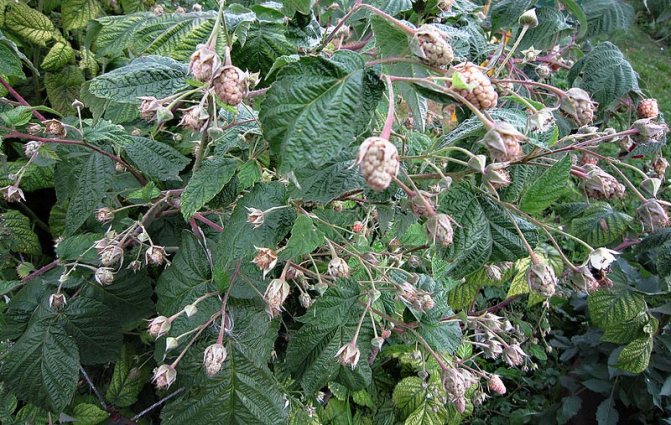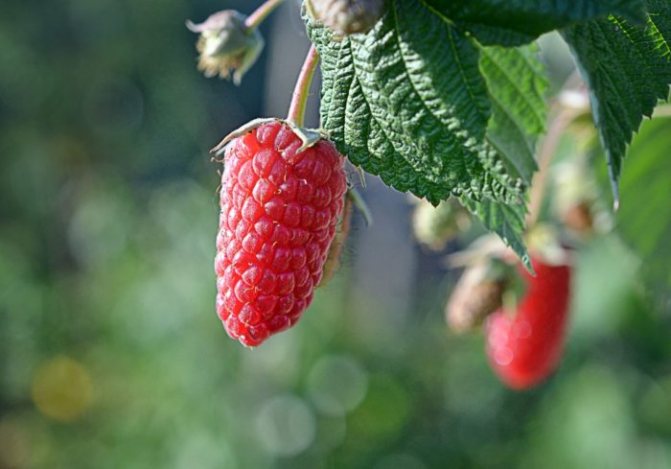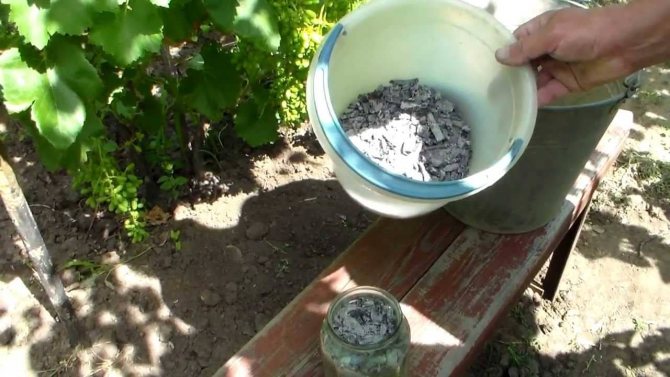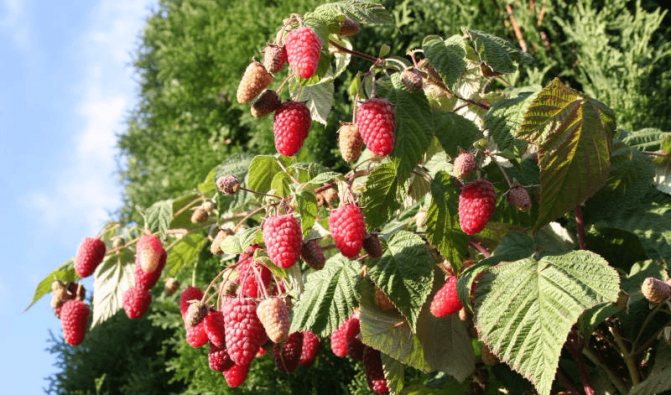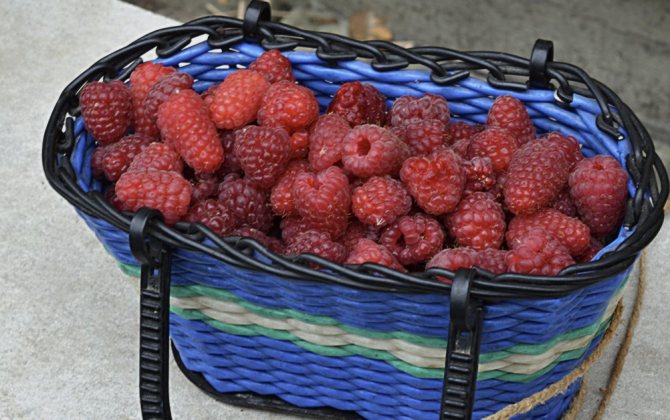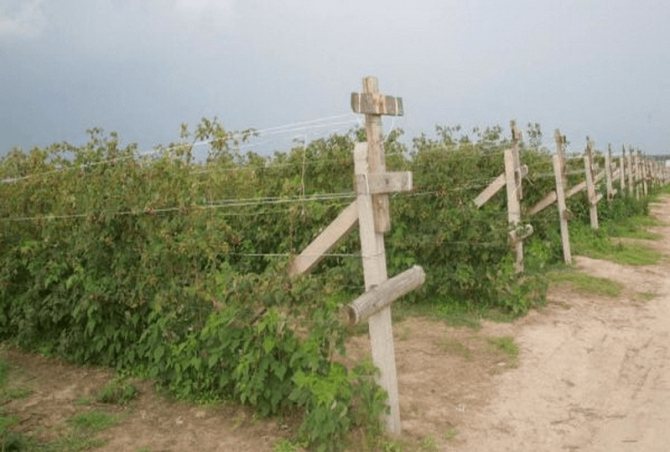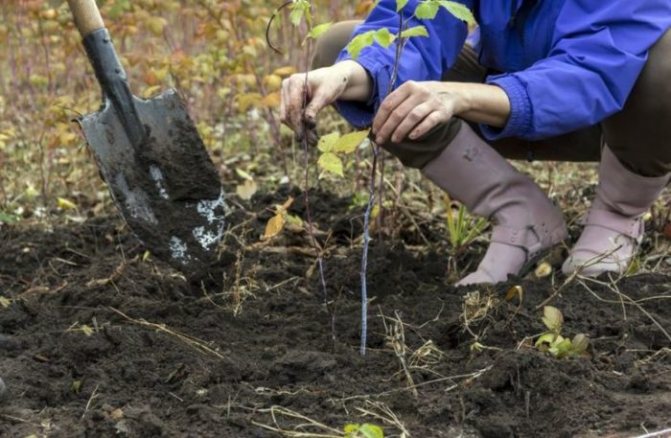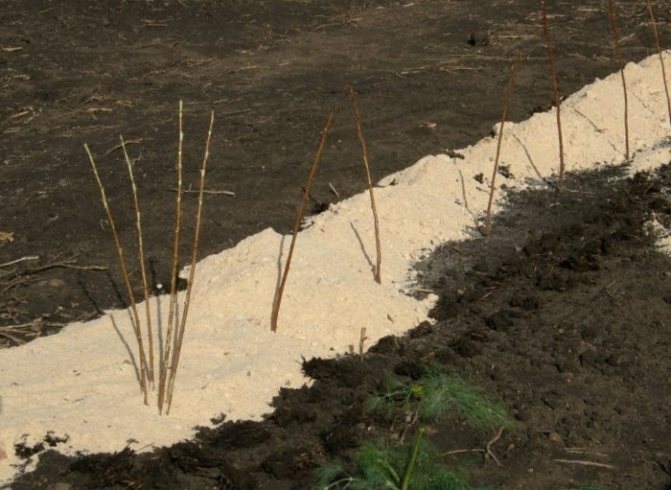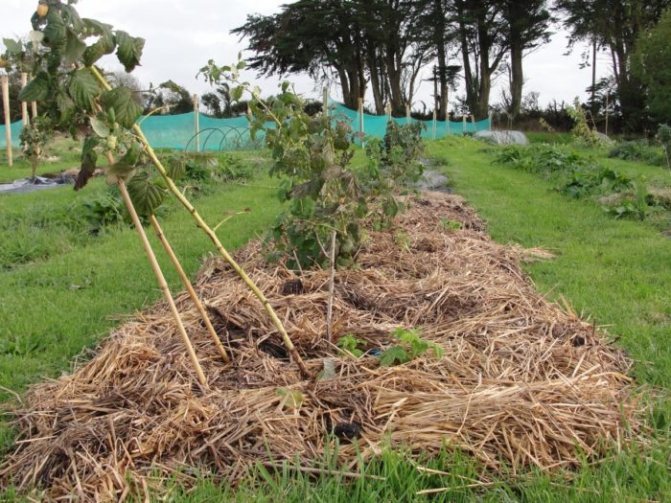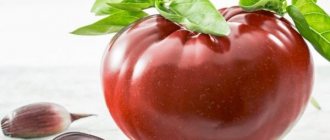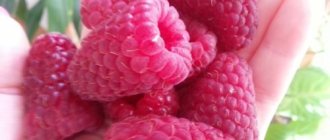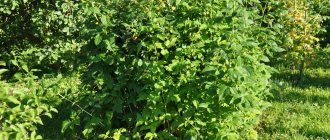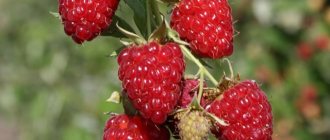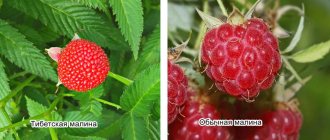Description of the variety
Photo:
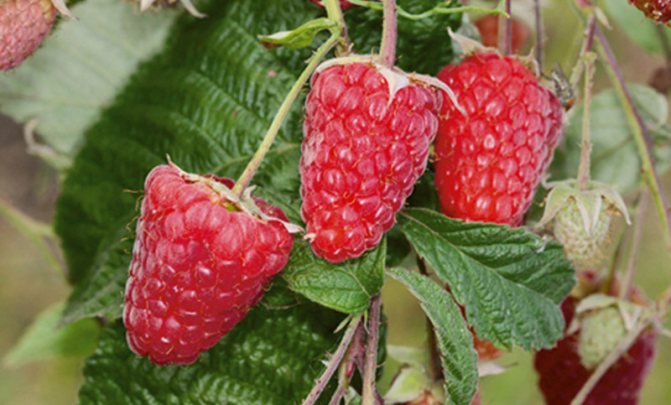
Red raspberries Bryansk marvel of oblong conical shape, reaching 4 centimeters. Their average weight is 5-6 grams. The berries are covered with a slight waxy coating. There are instances that grow up to 11 grams. Sweet, with a slight sourness, the taste of berries is rated on a tasting scale of 4 points out of a possible 5.
Raspberry fruits Bryansk miracle contain 5.6% sugars, 2.2% organic acids, 0.3% carotene.
Consisting of 5-7 thick shoots covered with a small number of thorns, the compact semi-sprawling bush of raspberries Bryanskoe Divo grows medium in size, reaching 1.5-1.8 meters in height.
The edges of large dark green leaves are serrated. This variety differs from other varieties of raspberries in that 2 fruit branches grow from each shoot. Powerful stems in the initial growing season have a weakly expressed anthocyanin shade, which becomes more intense towards autumn.
Harvest raspberries Bryanskoe miracle has a long fruiting period, which begins in August and lasts until the first frost. This feature is typical for remontant varieties that yield crops already in the first year of planting.
Common raspberries bear fruit on two-year-old shoots. The possibility of obtaining two yields is another feature of these varieties. Berries of remontant varieties ripen on last year's and annual shoots.
History of creation
Bryansk Divo (Bryansk Miracle) was bred by Russian breeders - academician of the Russian Academy of Agricultural Sciences with a world name I.V. Kazakov and his student, Doctor of Agricultural Sciences S.N. Evdokimenko. Work on the creation was carried out at the Kokinsky strong point (Bryansk region), which is the generally recognized "crimson capital" of Russia. The variety was obtained as a result of free pollination of a large-fruited interspecific numbered form 47−18−4, and in 2001 it was allocated to the elite under the number 8−79−2. In 2006, it received the name and has already multiplied as a new variety. Russian patent No. 3940 was issued in 2008. The patent expires in 2038. This raspberry is included in the State Register of Breeding Achievements of the Russian Federation. The copyright holder is the All-Russian Institute of Selection and Technology for Horticulture and Nursery, Moscow.
Productivity, collection and storage
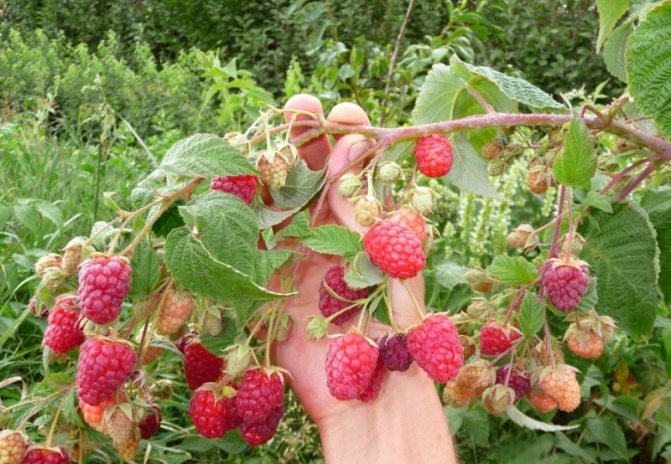

Raspberry berries Bryanskoe miracle begin to ripen from the top and gradually descend to the lower tiers. The yield of the variety cannot be compared with any other. 3-4 kilograms of berries are harvested from one bush per season. It is difficult for gardeners who grow raspberries for sale to find the best variety.
The terms of fruiting, depending on the region, may vary, but its duration, on average, is several months. Raspberries ripen unevenly.
Only red berries should be picked. Harvesting is carried out every 1-2 days, in the morning, when the dew has melted, or in the evening, in dry weather. During the high season, many fragrant large berries can be picked every day. For transportation, it is desirable that the berries are with a stalk.
They put the crop in baskets with a capacity of up to 4 kilograms. It is not recommended to use large containers, in which the raspberries on the bottom can wrinkle. At a temperature of 0 ° C, berries are stored for no more than 5 days. It is advisable to consume or process them immediately.Fruits of the Bryansk Divo variety are suitable for making juices, jams, marmalades, and preserves.
Harvesting
The berries ripen in the second half of August, the collection continues until stable cold weather (short-term September frosts up to -3 ° C, this raspberry tolerates without damage and continues to bear fruit). The yield is high; 3-4 kg of berries can be harvested from a bush per season.


The crop can be harvested before the autumn frost
Fruits are dense, transportable, can be stored in the refrigerator for up to 48 hours. The use of berries is universal. They can be eaten fresh, dried, frozen. Raspberries make excellent jam with clear syrup and whole berries, jellies, jams, compotes.
If the harvest of remontant raspberries did not have time to ripen, you need to tie the shoots with berries in bunches and put them in a warm, bright place in water, which needs to be changed every 2-3 days. The fruits will acquire sweetness and aroma.
Video: pitted raspberry jam
Gardeners reviews
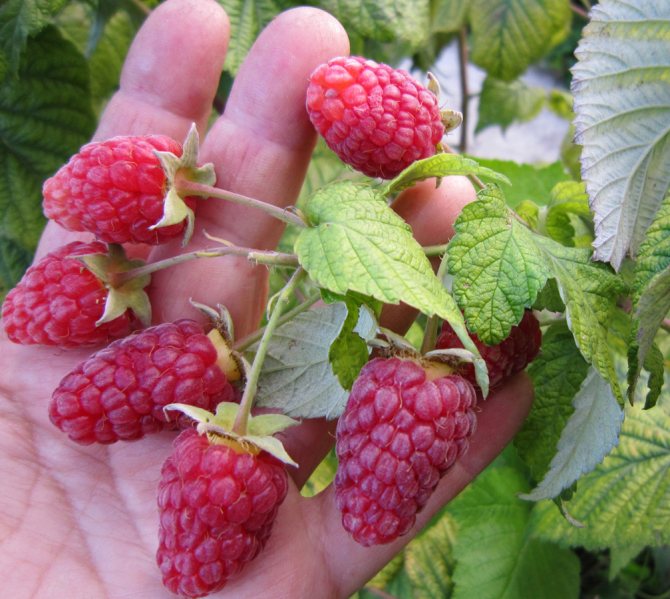

Raspberry Bryansk miracle fell in love with many gardeners who successfully grow it on their plots. Their reviews speak of the many advantages of the variety, among which are:
- large berries;
- long fruiting period;
- high productivity;
- medium heat resistance and drought resistance;
- good transportability.
Gardeners consider the disadvantage of the Bryansk diva to be a weak resistance to diseases. This variety is especially susceptible to fungal infections. With insufficient lighting, the berries lose their sugar content and become small. The variety's exactingness for watering does not allow it to perform best in arid regions.
Watering
Raspberry "Bryansk Divo" is very responsive to organic fertilizers. Planting and grooming is time consuming but well worth the effort. However, there is another important point - watering. This variety is very picky about watering, especially on dry days. The root system is located at a depth of about two centimeters. So you will have to water the plantings often. At the same time, remember that stagnant water will lead to the death of the root system. Therefore, before watering, pick up a clod of earth and squeeze it. If it crumbles easily, then a new portion of moisture is definitely needed.
How to grow the Bryansk miracle?


It is not recommended to plant raspberries on heavy soils; it prefers loamy and sandy loam soils. This plant also reacts negatively to a lack of light, so it is better to choose a site for it that is not shaded by tall crops or buildings.
The location of groundwater is not allowed closer than 1.5 meters from the soil level. You cannot plant raspberries near tomatoes, potatoes or strawberries, since these crops have common diseases.
The final formation of the root system of the bushes occurs in September. The most suitable time for planting is October, but you can plant a crop in March-early April before budding. The soil for planting raspberry bushes begins to be prepared in a month. If you plan to plant in the spring, you can prepare the soil in the fall or 2 weeks before the planned date.
The raspberry variety Bryanskoe Divo is recommended to be planted in a trench manner, subsequently tying it to a trellis. Landing is carried out in the following sequence:
- Dig a half-meter wide furrow with a depth of 40 centimeters.
- Leave a distance of 1.5-2 meters between the rows, 50 centimeters between the bushes.
- Fill the bottom of the trench with a 20 cm layer of rotted manure or compost.
- Distribute superphosphate evenly on top (30 grams per plant).
- It is advisable to choose for planting annual seedlings with shoots 8-10 millimeters thick, having a developed root system with a minimum length of 15 centimeters.
- At a distance of 30-35 centimeters from the soil, the seedling should be shortened.
- Then place the seedling in the trench, spread its roots and sprinkle with soil.
- Leave the root collar 3-5 centimeters above the soil surface.
- Water the planted plants using 10 liters of water per 1 meter of furrow.
When planting, it is not recommended to use fertilizers that contain nitrogen: this slows down the rooting of the plant.
Landing features
It is best to plant remontant varieties of raspberries in the fall, at the end of October. Before the onset of stable cold weather, it will have time to take root, and next summer it will give its first harvest. But in the northern regions with cool summers and clay soils that retain moisture well, planting in early spring is also permissible.
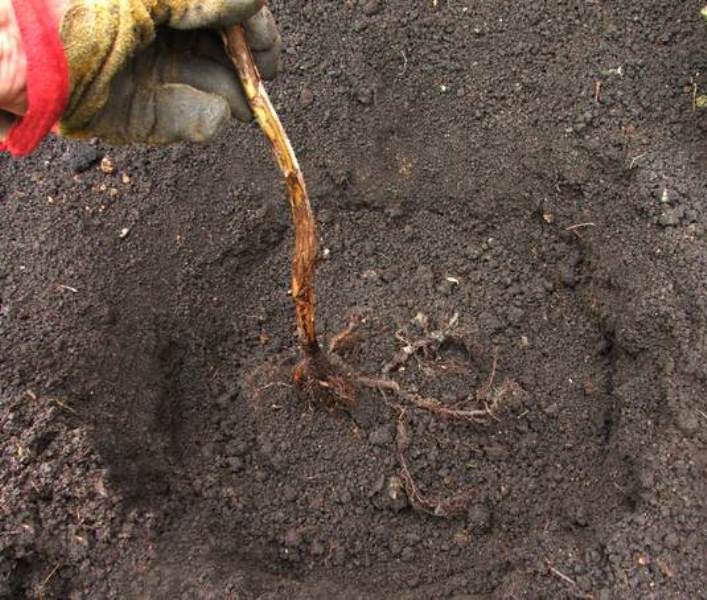

Planting remontant raspberries is best at the end of October.
You can arrange raspberry bushes in rows and in separate groups. The main thing is to maintain the correct distance. In a row - at least 70 cm between plants, and between trenches or individual bushes - 2 m... A prerequisite is that the place must be sunny and protected from winds, without stagnant moisture. The groundwater level should not exceed 1.5 m.
In damp terrain, the bushes are planted on ridges 50 cm high.
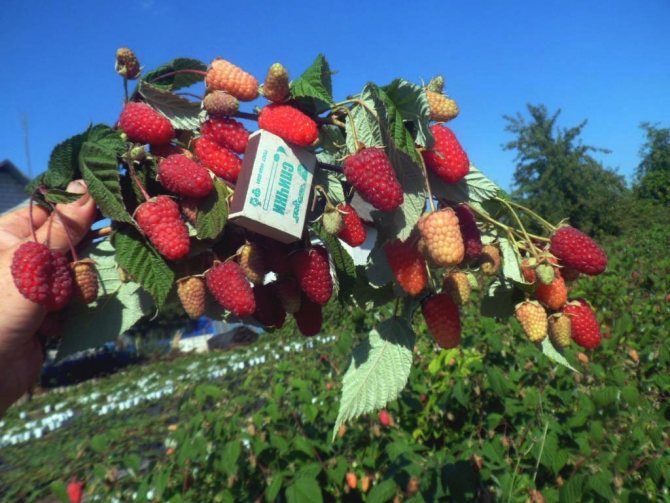

Raspberries need a sunny spot, sheltered from the wind.
Site preparation for planting
For a variety to reveal its unique qualities, the soil under the bushes must be loose, fertile and moist.
For autumn planting, the place is prepared in the spring. For this you need:
- Dig up the area allocated for the berry, removing the roots of weeds, especially wheatgrass, May beetle and wireworm larvae, level with a rake.
- Dig trenches or pits 0.5 m deep and 0.5 m wide from south to north, laying the fertile (top) layer to one side.
- Fill the bottom with pieces of removed turf with roots up, chopped branches, weeds, tamp.
- Fill with a mixture of 1 part of fertile soil, 2 parts of humus or compost, river sand. Add stove ash from deciduous trees - 1 liter per 1 m2.
- Add 1 tbsp. any complex fertilizer per 1 m of a trench or in one hole.
- Water abundantly (2-3 buckets of water per 1 m2).
- Cover with a dark non-woven fabric and leave until autumn.
- Sow the soil around the trenches or holes prepared for planting for the summer with ground cover plants with a superficial root system such as bent grass or low-growing marigolds. Remove weeds in a timely manner.
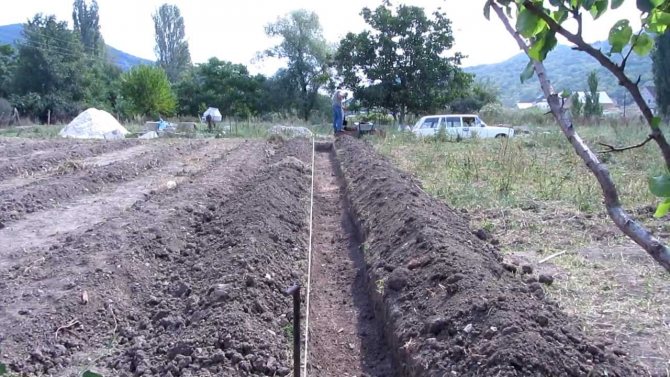

A place for raspberries is prepared in advance
Selection of seedlings
It is necessary to purchase seedlings in proven garden centers, from experienced gardeners engaged in the cultivation of this culture, in order to avoid misgrading and disappointment. When choosing planting material with an open root system, it is necessary to pay attention to the condition of the roots. They should be branched and fibrous, the wood of the branches should be light, a fresh scratch on the bark should be green.
It is useless to plant plants with fresh leaves in autumn, the bushes will die. Before planting, the green part of the shoot must be cut off, leaving 25-30 cm.
Raspberry seedlings with a closed root system can be transplanted at any time of the year, but better in spring. The root system of such a plant should braid the entire space of the pot and be visible through the drainage holes. You do not need to remove the top and pick off the leaves from such a bush.
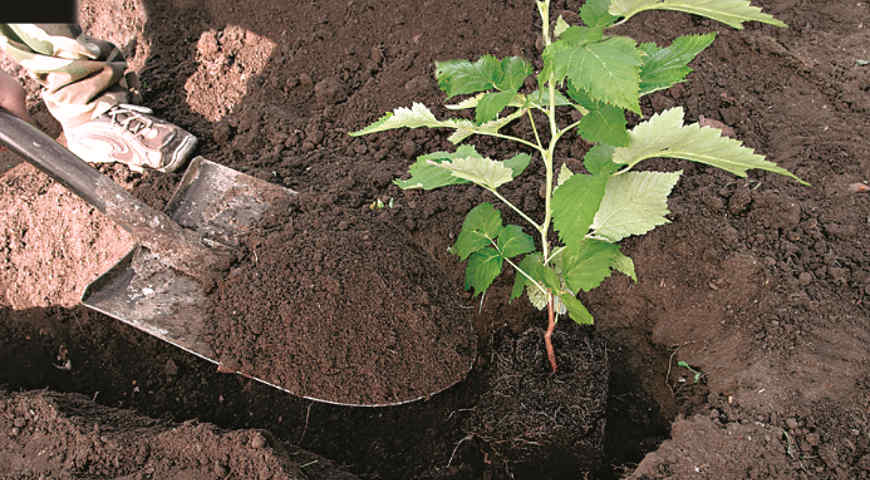

Seedlings with a closed root system can be transplanted at any time of the year, but better in spring
Autumn planting of seedlings
In the fall, covering material is removed from the prepared trenches and pits. The seedlings are examined, the root system is checked, the blackened or broken roots are removed, they are placed for 5-6 hours in water with the addition of Kornevin or Heteroauxin for better survival and root development. Then they start landing:
- Dig holes in the prepared soil, commensurate with the root system of the seedling.
- Plants are installed vertically in them, carefully spreading the roots to the sides so that they do not bend upwards.
- Sprinkle with removed soil so that the root collar of the shoot is at the same level as in the nursery. Shake the seedling lightly to compact the soil around the roots.
- Water abundantly.If the roots are bare, add earth.
- Planting is mulched with humus, compost, peat, rotted sawdust.
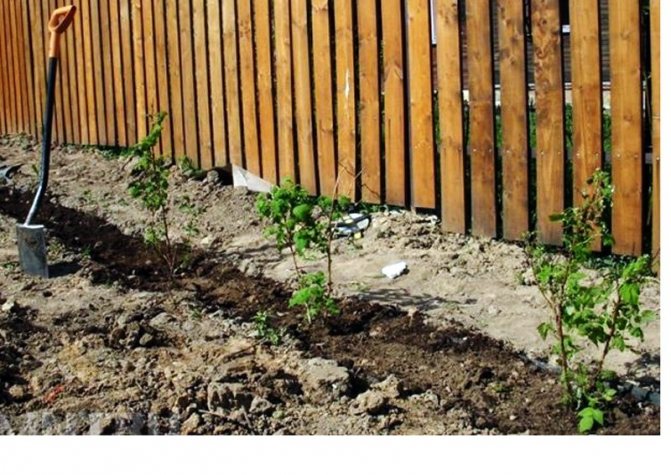

Remontant raspberry bushes, planted in autumn, bloom in summer and give the first harvest
Video: description of raspberry Bryansk marvel and its planting
Diseases and their treatment
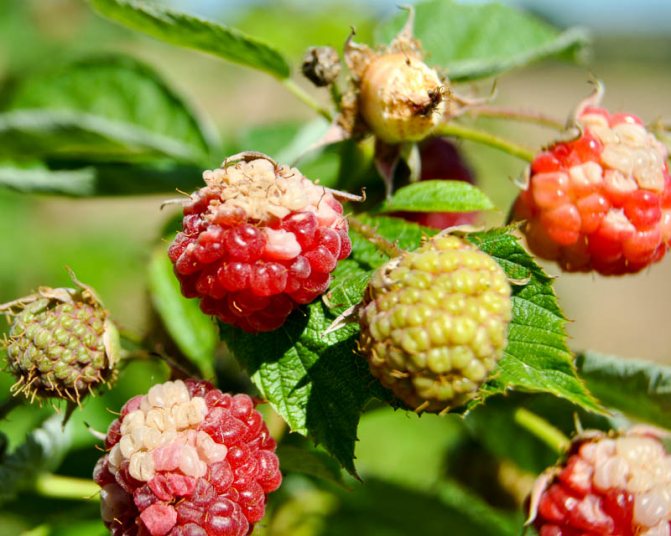

White spot
Raspberries Bryansk marvel can be affected by some dangerous diseases:
- White spot. It is characterized by the appearance of rounded light-brown spots on raspberry leaves, which later brighten. After collecting the fruits for treatment, the bushes are sprayed with a solution of colloidal sulfur (40 grams per bucket of water).
- Purple spot. Purple spots form on the leaves and branches, which then turn brown. The diseased bush does not produce berries. To cure raspberries from this disease, the bushes are sprayed with a 1% Bordeaux mixture before the growing season or after picking berries.
- Gray rot. The disease is manifested by a grayish bloom on the leaves and hairs on the fruits, an unpleasant smell of berries. In early spring, the bushes and the ground under them are treated by dissolving 40 grams of the Hom preparation in a bucket of water. 1 bucket is enough per hundred square meters.
- Rust. Orange bumps on leaves with spores inside signal the disease of raspberries with rust, which leads to drying out of diseased branches. In the spring, 200 grams of Nitrafen are diluted in 10 liters of water to fight rust and the plant is sprayed with the resulting solution. When the crop is harvested, it is recommended to treat the raspberries with a solution of 2 Oxychom tablets diluted in a bucket of water.
- Curliness. This disease is characterized by the curling of the leaves inward and the cessation of fruiting.
- Mosaic. On the leaves with it, spots of light green or cream are visible, the berries are not tied.
- Overgrowth. On the roots of the plant, many small, thin shoots first grow, and then fruit setting stops.
Overgrowth, mosaic, and curly hair cannot be cured. Diseased bushes can only be dug up and burned.
Main positive and negative aspects
Like every crop, this plant has its pros and cons:
- The variety is resistant to disease, extreme temperature changes and drought.
- The yield of this hybrid pleases gardeners.
- In addition to culinary purposes, it is also used in medicine.
- After ripening, the berries do not fall.
- The plant does not tolerate transportation well, therefore it does not let the juice in for only two days.
- Too many spikes will interfere with quick collection and will require additional protection.
See also
How to quickly propagate remontant raspberries, methods and timing of harvesting cuttingsRead
Pest control
Many pests also show interest in raspberries: raspberry beetles, weevils, stem flies, gall midges, and kidney moths. To eliminate the weevil, the plant is sprayed with a solution prepared from 1 tablet of the Spark preparation and a bucket of water before the flower buds bloom.
When the crop is harvested, raspberries can be sprayed with 0.2% Karbofos. To combat raspberry beetles that eat leaves and stalks, the bushes are sprayed with Confidor's solution before flowering (1 milliliter per bucket of water).
To eliminate bud moths and stem flies, before flowering, raspberries are treated with a 0.3% solution of Karbofos. To combat gall midge, the bushes and the ground around them are sprayed with Aktellik.
For prophylaxis, it is recommended to burn leaves in autumn, to dig up the ground in spring and autumn to a depth of at least 15 centimeters. During the season, it is necessary to loosen the soil 5-6 times and pull out the weeds.
Reproduction
To reproduce the Bryansk miracle, use:
- cuttings;
- seeds;
- processes.
When grafting, either green cuttings or root cuttings are chosen.
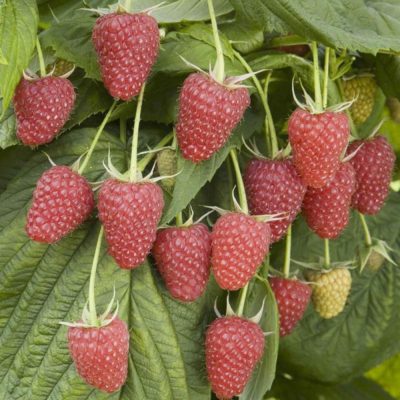

For the first case, reproduction is carried out in June with young shoots with a height of 5 cm, which are cut off at ground level. They are planted in a greenhouse at an angle of 45 degrees. After rooting, after 14 days, they are fed. A week passes, they land in an open area.And in the fall, the grown cuttings are sent to the raspberry tree.
For the second case, at the end of summer, the roots are dug up and cut into pieces. They are planted in soil that is pre-fertilized. Watering, mulching, and they hibernate under spruce branches. When spring comes, they are covered with plastic wrap. After the appearance of green shoots, the film is removed. In the fall, the planting material is sent to the raspberry plant.
Propagated by seeds using the following technology:
- the pulp of the berries is pounded and filled with water;
- what floats, is collected and dried;
- sow and sprinkle with earth;
- after the appearance of the leaves, the plants dive and are planted in pots, where they develop in the warmth;
- when they reach a length of 20 cm, they are planted in a raspberry tree.
More on the topic: Cardinal raspberries
For propagation of shoots, biennial plants are used. They are waiting for small shoots to grow up to 15 cm in order to remove them from the ground and transplant to another place. In the new place, the shoots are mulched and watered abundantly.
Important! The shoots must be replanted in the evening.
Raspberry care
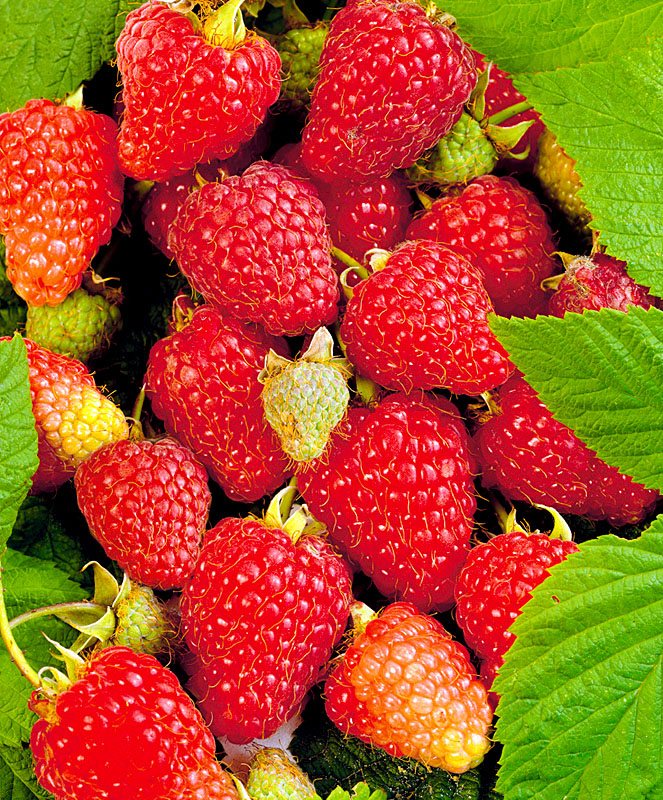

The Bryansk miracle will delight you with a rich harvest only with proper and timely care.
Top dressing
Providing shrubs with fertilizers is an important step in the care. At the beginning of the growing season, a mullein solution is used to feed raspberries (for 10 liters of water - 2 kilograms). Fertilizer is applied to the trenches dug at a distance of half a meter from the bush. One plant requires 5 liters of nutrient composition. Re-feeding with a similar solution is carried out in the last decade of June.
In addition to organic matter, it is important to enrich the soil with minerals. Top dressing with phosphorus is carried out in the spring with the introduction of complex fertilizers, for example, 50-100 grams of nitroammofoska per square meter.
Watering
Malina Bryansk Marvel needs timely watering. The soil needs to be moistened depending on the weather conditions. To determine the need for moisturizing raspberries, you need to dig a lump of earth near the bush and squeeze it with your hands. With a sufficient level of soil moisture (70%), it forms well and does not disintegrate.
The need for watering is indicated by the crumbling of the lump. At a distance of 70 centimeters from the row, you need to make 2 furrows 10 centimeters deep and pour water into them at the rate of 3-4 buckets per 1 meter of the trench.
Pruning
Raspberry seedlings grow shoots during the first growing season, and by August they ripen the fruits. Do not leave the stems for the next year: in winter they can be attacked by pests and viruses. In October-November, at the level of 3 centimeters from the soil, they need to be cut off.
Frozen or dried stems with the onset of spring are recommended to be shortened to the first healthy bud. This should be done in April: by this time the kidneys have already swollen enough and this will make it possible to determine which of them are healthy.
Agrotechnics
Raspberries of the remontant type are more demanding on nutrition, moisture, light than ordinary varieties.
Top dressing
At the beginning of the season, when there is an intensive build-up of green mass, preference is given to nitrogen fertilizers. Urea (30 g / m2) is added every 10 days. In the middle of summer, shrubs are fertilized with nitrophos (60 g / 10 l), at the end of the season - with superphosphate (50 g) and potassium salt (40 g / m2). For regular feeding, you can use Kemir's complex fertilizer (50 g / 10 l) at the rate of 500 g of solution per bush.
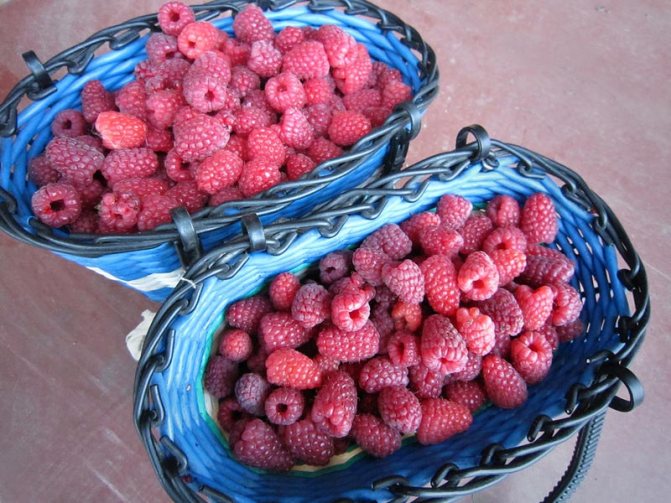

Remaining raspberries have a much higher nutritional requirement than ordinary raspberries, but their yield is 2 times higher.
Organic fertilizers are not inferior in composition to mineral additives. Under the bushes, solutions of mullein or chicken droppings rich in nitrogen compounds are introduced every 10 days. They are diluted in water 1:10 and 1:20 and the plants are fed (5 l solution / m2). After applying the fermenting liquid, the soil should be well watered. The source of calcium, potassium, magnesium and other elements necessary for the plant is ash (500 g / m2).
A good feed for raspberries is nettle infusion. 1 kg of grass is poured into 20 liters of water, 3 kg of manure and 200 g of ash are added. Leave to ferment for a week.The resulting infusion is diluted with water 1:10 and 500 ml is introduced under the bush.
Root dressing should be combined with foliar dressing. Application of liquid fertilizers Uniflor-micro (1 tbsp. L / 10 l), Kristalon (30 g / 10 l) to the sheet allows you to quickly replenish the deficiency of trace elements, has a general strengthening effect on plants, and helps to increase yields.
Recent Entries
5 of my favorite tomato varieties that are great for pickling 7 super early and delicious potatoes to plant in 2020 6 rare 2020 tomato varieties that will bring you a decent harvest
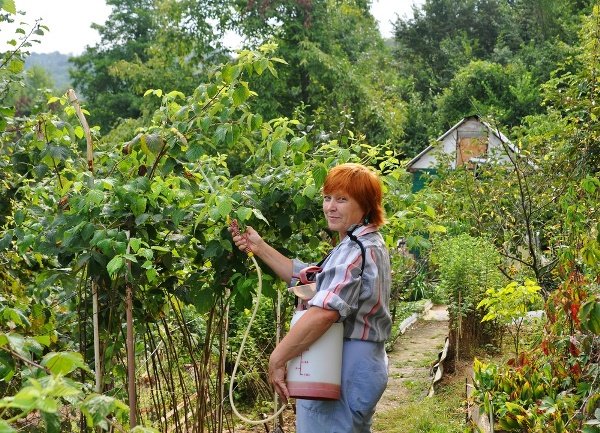

Fertilization on the leaf allows you to quickly saturate the plants with the necessary nutrients
Watering and loosening
The culture is hygrophilous; in extreme heat, in the absence of watering, the berries become very shallow. Moisten the raspberry tree every 7 days (10 liters per bush). However, stagnation of water with excessive watering has a depressing effect on plants.
There are several ways to irrigate a raspberry tree: sprinkling, through grooves, drip irrigation. It is better to supply water through a drip system, which allows you to directly moisturize the rhizome and significantly save water consumption. This type of irrigation is especially convenient on large plantations.
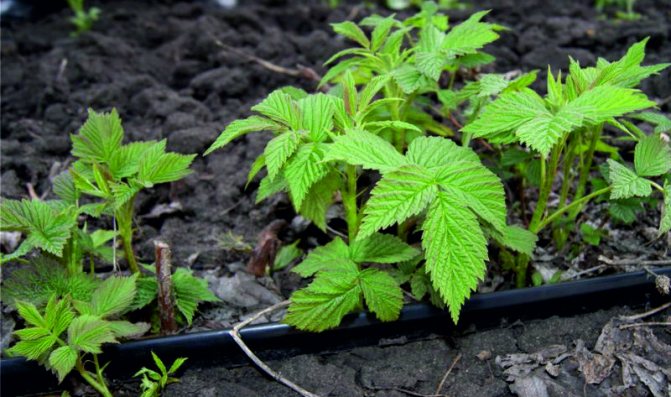

With drip irrigation, water evenly flows through the droppers in belts to the plant roots
When watering along grooves made around a bush or along a row to a depth of 15 cm, water is brought in from a bucket or hose. After absorbing moisture, the grooves must be sealed. On hot days, it is advisable to use sprinkler irrigation with sprinklers, which moistens not only the soil, but the entire bush. Such watering is carried out in the morning and evening hours to avoid foliage burns and reduce moisture evaporation. Before the onset of cold weather, in the absence of rain, pre-winter watering is required (20 l / bush).


When simulating rain, the soil around the plants, leaves and shoots is well moistened
After each watering, the soil is loosened to remove the crust that prevents air from reaching the roots. Loosening in the root zone is carried out to a depth of no more than 7 cm. Then mulch is laid - hay, straw, humus. The mulching layer 10 cm thick improves the structure of the soil, does not allow moisture to evaporate quickly, and protects the roots from freezing in winter.
Growing on a trellis
The raspberry Bryanskoe miracle has long side shoots, they can break under strong gusts of wind. Lodging of branches loaded with crops is also possible, since the berries are distributed over 2/3 of their length. Therefore, it is necessary to tie the shoots to the support. It is not difficult to install it yourself. A stake is installed near the bush, to which the bush is tied.
With a linear planting of the raspberry tree along the row, every 3 m, pillars are dug in and the wire is pulled in 2 rows. Tying shoots to the trellis is carried out at a height of 50 cm and 1.2 m. You can use the fan method of tying to the support. On both sides of the bush, pegs are installed, to which part of the stems of one plant and part of the branches of the neighboring plant are tied at different heights.


To protect the shoots from lodging under the weight of berries, raspberries are grown on a trellis
Pruning
Pruning remontant raspberries has its own characteristics. If the berry is grown for one late summer harvest, all shoots are mowed at the end of October. If they plan to get 2 crops per season, only two-year-old stems that have fruited are removed, annual ones are shortened by 15 cm.
At the beginning of the season, they examine the bush, remove the dried stems. In the summer, excess shoots and root suckers are cut off, leaving no more than 6 branches to provide them with adequate nutrition. With this pruning, the bush is well ventilated and evenly illuminated.


Raspberry pruning is carried out when cold weather sets in, shoots are cut at ground level
The berries begin to ripen from the top, gradually descending to the lower tiers.If the lowest flowers are removed at the bud stage, the remaining fruits will be noticeably larger and sweeter.
Video: how to trim remontant raspberries
Preparing for winter
The variety is frost-resistant, winters well in central Russia without shelter. The root system can withstand a significant drop in temperature with a snow cover of 30 cm. However, in snowless winters, with a sharp change in severe frosts with thaws, the rhizomes can freeze slightly. Prolonged rains in warm autumn promote the growth of new shoots, which also reduces the level of winter hardiness.
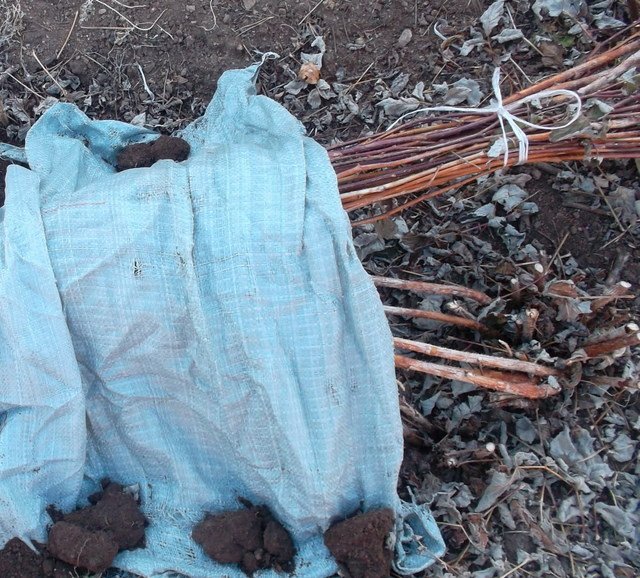

Annual shoots are bent in an arc, tied to a stretched wire and covered with non-woven material
If you plan to get two crops, only two-year-old shoots are cut. Annuals are left. The root zone is moistened, mulched with humus. The left branches are bent, attached to the established arcs and covered with agrofibre.
Double fruiting greatly weakens the plants, decreases their winter hardiness, this method is recommended only for the southern regions. In temperate climates, late summer fruiting with the removal of the aboveground part is more productive. When cold weather sets in, all the shoots are mowed, the area is cleared of leaves and debris, watered and a layer of mulch is laid. In this case, insulation is not required.
Reproduction
Raspberry Bryansk miracle gives few replacement shoots, little root suckers are formed - 2–4 per bush, so it does not fill the garden space and does not drown out the crops growing in the neighborhood. Several methods are used for breeding varieties.
The culture is easily propagated by green cuttings. In June, young shoots 5 cm high are cut underground and planted in a greenhouse at an angle of 45 degrees. Moisturize and ventilate regularly. Rooting takes 2 weeks. Green plants need to be fed with complex fertilizer and a week later planted in the garden according to the 10x30 scheme for growing. In the fall, they are transplanted to a prepared place.
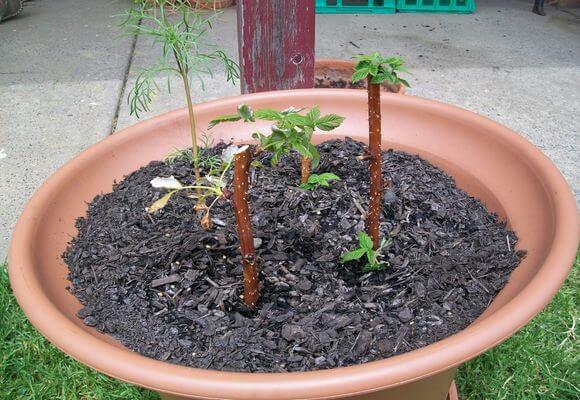

It is easy to propagate raspberries by cuttings
Raspberries are also bred using root cuttings. At the end of the season, the roots are cut into 10 cm pieces and planted in a fertilized area. Water, mulch the soil and cover with ephedra for the winter. In early spring, having freed the beds from spruce branches, stretch a film over them. When green offspring appear, the film is removed. In the fall, the seedlings are transplanted.
Video: reproduction of raspberries by root cuttings
You can divide the bush into parts with a root and shoots and plant it separately. The branches must be shortened to 45 cm.


A bush with well-developed roots can be divided into several parts
The seed propagation method is rarely used, it is rather laborious and does not guarantee the preservation of varietal traits.


